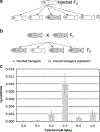Detection of mercury in aquatic environments using EPRE reporter zebrafish
- PMID: 18537037
- PMCID: PMC8898586
- DOI: 10.1007/s10126-008-9113-x
Detection of mercury in aquatic environments using EPRE reporter zebrafish
Abstract
It has been proposed that transgenic zebrafish could be designed to detect low levels of chemical contaminants that cause oxidative stress in aquatic environments, such as heavy metals or pesticides. In this paper, we describe such a transgenic zebrafish that produces a luciferase-green fluorescent protein (LUC-GFP) fusion protein under conditions of oxidative stress. The reporter gene expression is under the regulation of the electrophile responsive element (EPRE), which activates gene expression in response to oxidative stressors. The GFP component of this fusion protein allows us to visually detect reporter gene activity in live animals to determine if activity is localized to a particular tissue. The luciferase component is capable of returning a quantitative assessment of reporter gene activity that allows us to determine if reporter gene activity is directly correlated to the concentration of the chemical inducer. We have tested this reporter construct in both transient and stable transgenic fish after exposure to a range of HgCl(2) concentrations. GFP expression from the EPRE-LUC-GFP construct was inducible in transient assays but was below the limit of detection in stable lines. In contrast, we observed inducible luciferase activity in both transient assays and stable lines treated with HgCl(2). We conclude that the EPRE is capable of driving reporter gene expression in a whole animal assay under conditions of oxidative stress. Furthermore, expression was induced at HgCl(2) concentrations that do not result in obvious morphological defects, making this approach useful for the detection of low levels of oxidative contaminants in aquatic environments.
Figures





Similar articles
-
Transgenic zebrafish as sentinels for aquatic pollution.Ann N Y Acad Sci. 2000;919:133-47. doi: 10.1111/j.1749-6632.2000.tb06875.x. Ann N Y Acad Sci. 2000. PMID: 11083105
-
Oxidative stress in zebrafish cells: potential utility of transgenic zebrafish as a deployable sentinel for site hazard ranking.Sci Total Environ. 2001 Jul 2;274(1-3):183-96. doi: 10.1016/s0048-9697(01)00742-2. Sci Total Environ. 2001. PMID: 11453295
-
Transgenic fish systems and their application in ecotoxicology.Crit Rev Toxicol. 2015 Feb;45(2):124-41. doi: 10.3109/10408444.2014.965805. Epub 2014 Nov 14. Crit Rev Toxicol. 2015. PMID: 25394772 Review.
-
High-frequency generation of transgenic zebrafish which reliably express GFP in whole muscles or the whole body by using promoters of zebrafish origin.Dev Biol. 1997 Dec 15;192(2):289-99. doi: 10.1006/dbio.1997.8779. Dev Biol. 1997. PMID: 9441668
-
Genetic tools for multicolor imaging in zebrafish larvae.Methods. 2013 Aug 15;62(3):279-91. doi: 10.1016/j.ymeth.2013.07.028. Epub 2013 Jul 22. Methods. 2013. PMID: 23886907 Review.
Cited by
-
The transcriptional response to oxidative stress during vertebrate development: effects of tert-butylhydroquinone and 2,3,7,8-tetrachlorodibenzo-p-dioxin.PLoS One. 2014 Nov 17;9(11):e113158. doi: 10.1371/journal.pone.0113158. eCollection 2014. PLoS One. 2014. PMID: 25402455 Free PMC article.
-
Development of a fluorescent transgenic zebrafish biosensor for sensing aquatic heavy metal pollution.Transgenic Res. 2016 Oct;25(5):617-27. doi: 10.1007/s11248-016-9959-z. Epub 2016 Apr 27. Transgenic Res. 2016. PMID: 27120052
-
Application of transgenic zebrafish for investigating inflammatory responses to nanomaterials: Recommendations for new users.F1000Res. 2025 Jun 23;12:51. doi: 10.12688/f1000research.128851.2. eCollection 2023. F1000Res. 2025. PMID: 40656220 Free PMC article. Review.
-
Selenoneine, a novel selenium-containing compound, mediates detoxification mechanisms against methylmercury accumulation and toxicity in zebrafish embryo.Mar Biotechnol (NY). 2013 Oct;15(5):559-70. doi: 10.1007/s10126-013-9508-1. Epub 2013 May 25. Mar Biotechnol (NY). 2013. PMID: 23709046 Free PMC article.
-
Fishing on chips: up-and-coming technological advances in analysis of zebrafish and Xenopus embryos.Cytometry A. 2014 Nov;85(11):921-32. doi: 10.1002/cyto.a.22571. Epub 2014 Oct 6. Cytometry A. 2014. PMID: 25287981 Free PMC article. Review.
References
-
- Baranowska-Dutkiewicz B (1982) Evaluation of the skin uptake of mercuric chloride in man. J Appl Toxicol 2:223–225 - PubMed
-
- Carvan MJ III, Solis WA, Gedamu L, Nebert DW (2000) Activation of transcription factors in zebrafish cell cultures by environmental pollutants. Arch Biochem Biophys 376:320–327 - PubMed
-
- Carvan MJ III, Sonntag DM, Cmar CB, Cook RS, Curran MA, Miller GL (2001) Oxidative stress in zebrafish cells: potential utility of transgenic zebrafish as a deployable sentinel for site hazard ranking. Sci Total Environ 274:183–196 - PubMed
-
- Dave G, Xiu RQ (1991) Toxicity of mercury, copper, nickel, lead, and cobalt to embryos and larvae of zebrafish, Brachydanio rerio. Arch Environ Contam Toxicol 21:126–134 - PubMed
-
- Day RN, Kawecki M, Berry D (1998) Dual-function reporter protein for analysis of gene expression in living cells. Biotechniques 25:848–856 - PubMed
Publication types
MeSH terms
Substances
Grants and funding
LinkOut - more resources
Full Text Sources
Molecular Biology Databases
